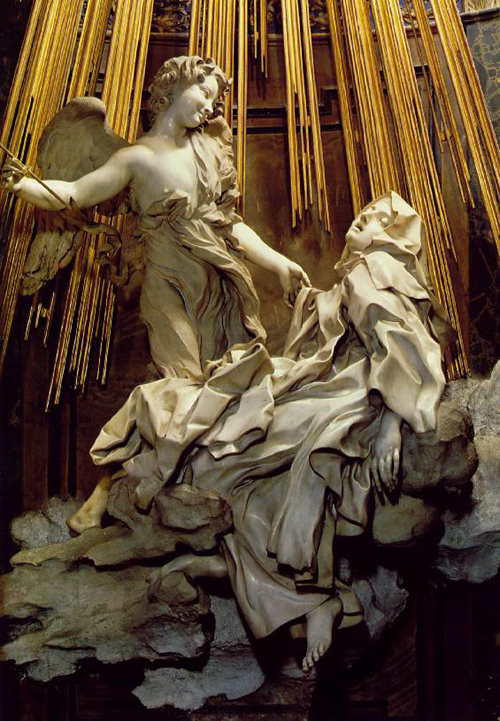On the eve of St Teresa of Avila’s feast day, this week’s picture shows Gianlorenzo Bernini’s sculpture of her as a swooning female mystic, eyes closed as she ascends heavenwards on a cloud. Beside her stands a sweetly smiling angel, lifting a fold of her drapery with one hand while preparing, with the other, to pierce her breast with a dart of Divine Love.
The backdrop to this scene of mystic transport is a sunburst of gilded stucco, lit from above as though by the light of heaven – the actual source of illumination being an artfully concealed lantern window cut high into the wall of the Cornaro Chapel in the Roman church of Santa Maria della Vittoria, where Bernini’s marble group is to be found. The artist, who was a brilliant theatrical designer as well as being the most prolific and innovative sculptor of the seventeenth century, seems to have regarded the Cornaro Chapel ensemble as his religious masterpiece. He described it, with sly understatement, as “one of my least bad works.”
Bernini completed his sculpture of the saint and her attendant angel in 1651, less than seventy years after the death of Teresa of Avila and just twenty-nine years after her canonisation by Pope Gregory XV. Her life and deeds were still fresh in the collective memory of Catholic Europe, while her Autobiography remained one of the most widely read works of devotional literature. Bernini’s depiction of her was based on Teresa’s description of one of her repeated mystical experiences:
“I would see behind me, on my left hand, an angel in bodily form… He was not tall, but short, and very beautiful, his face so aflame that he appeared to be one of the very highest types of angel who seem to be all afire… In his...

ITP 78: Saint Teresa in Ecstasy by Gianlorenzo Bernini
14-10-2001

